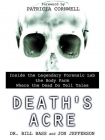Death's Acre: Inside The Legendary Forensic Lab The Body Farm Bill Bass (howl and other poems TXT) 📖

- Author: Bill Bass
Book online «Death's Acre: Inside The Legendary Forensic Lab The Body Farm Bill Bass (howl and other poems TXT) 📖». Author Bill Bass
The man who had sold the junker, it turns out, had served in the Pacific theater during World War II. While walking along a beach in Okinawa, he had stumbled across a crashed Japanese Zero; inside was the skull of the dead pilot, which our patriotic GI brought home as a war trophy. (In ensuing years I would encounter more World War II trophy skulls, almost all of them Japanese, almost none of them European in origin—an interesting commentary on our attitudes toward the dead from different cultures.) At some point between 1945 and 1973, the base of the Japanese pilot’s skull—his foramen magnum—was knocked out so a light bulb could be inserted into his cranium: The dead warrior had been reduced to a mere Halloween decoration.
Skull number two was a Native American skull, also dry, dusty, and far older than our floater. The search for the missing skull would have to continue. Meanwhile, the unsolved mystery was starting to cause a stink—literally. Most cities have morgues where bodies can be kept in cold storage until they’re identified and either claimed by relatives or buried by the local government. That’s not the case in many small, rural towns—like Kingston, the seat of Roane County, where our floater had surfaced once enough decomposition gases had built up in his abdomen to make him buoyant. The deputy didn’t want to take the smelly body back to Kingston with him, so I helpfully agreed to keep it at the university. The problem was, I didn’t have a cooler, either. With the weekend now at hand, I wrapped the body in plastic, sealed it the best I could, and stashed it in the mop closet of a rest room near my office. I’m not sure how many people were in the building when the janitor came in to mop the halls that weekend, but I expect everyone who was—and probably a few passing motorists outside—heard him when he opened the stinky bundle in his closet and saw what was inside. On Monday morning he made it crystal clear—in language equally plain to a scientist or a sailor—that, department head or not, I was never, under any circumstances whatsoever, to store rotting bodies in his mop closet or anywhere else in his building. One single infraction, I gathered, might result in the subsequent discovery of my own headless body in very short order.
Ever quick to take a hint, I sought help from my boss, the college dean. I explained our little dilemma, which he comprehended with swiftness and equanimity. Opening a campus telephone directory, he thumbed through the listings for the College of Agriculture, made a brief call, and solved my problem: The ag school had several farms outside of town, and on one of those farms stood a vacant building, a sow barn, which was basically an open, three-sided shed. The farm’s only neighbors were the prisoners in a county correctional facility, and they probably had better things to complain about than an occasional whiff of decomposition. It seemed like a good place to store bodies temporarily until we could clean and study the bones.
It worked fine for several years. Gradually, though, I started noticing something odd: Occasionally I would find a body in a slightly different position than the way I had left it a day or two before. I also noticed footprints and other signs of uninvited human visitors. Eventually we figured out what was happening. The convicts next door, working outdoors on the grounds of the penal farm, had discovered the sow barn’s gruesome new residents and had taken to sightseeing. So far nothing had been removed, but I didn’t want to take the chance of losing a crucial piece of forensic evidence—a skull containing a telltale bullet, for instance.
As I was mulling over the need for a new storage facility, along came Colonel Shy, telling me that merely warehousing bodies wasn’t enough. I needed to do more than just remove the rotting flesh from bodies; I needed to study it, observe it, learn everything it could tell me about death and decomposition. I couldn’t do that kind of research in a musty sow barn, especially not one located forty-five minutes away from my offices and labs. I needed someplace bigger, somewhere closer.
It was my sixth year as head of the anthropology department. By now our physical-anthropology faculty had expanded from one to three; our curriculum had grown from undergraduate courses to a full-fledged Ph.D. program; and we were beginning to attract some of the brightest and best graduate students in the nation. We had, in short, the resources to do something that had never been done before: to establish a research facility unlike any other in the world—a research facility that would systematically study human bodies by the dozens, ultimately by the hundreds; a laboratory where nature would be allowed to take its course with mortal flesh, under a variety of experimental conditions. At every step, scientists and graduate students would observe the processes, document variables such as temperature and humidity, and chart the timing of human decomposition. We would pick up where Sung Tz’u had left off seven centuries before.
The idea was simple; the implications—and the possible complications—were profound. By most cultural standards and values, such research could appear gruesome, disrespectful, even shocking. Yet the chancellor never questioned the wisdom of it; fortunately, he had watched and admired the





Comments (0)